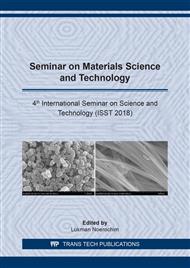p.109
p.115
p.124
p.130
p.136
p.145
p.151
p.156
p.161
The Kinetics of Magnesium Carbonate Crystallization for Traditional Salt Production Wastewater Recovery
Abstract:
The kinetics of crystallization of magnesium carbonate (nesquehonite) at room temperature (27°C) has been examined using an electrical conductivity method during process of nucleation. Magnesium carbonate hydrate from a reaction of magnesium chloride (MgCl2) and sodium carbonate (Na2CO3) in supersaturated condition was analyzed. Variations of batch reactor experimental are magnesium chloride initial concentration (500-3.000 mg/L) and operating pH (8-14). In this paper, we studied the crystallization kinetics of magnesium carbonate via an electrical conductivity method, a concentration monitoring method. By monitoring electrical conductivity during the solution reaction process, changes in [Mg2+] can be measured and an induction period of nucleation could be determined. Crystal has been formed was confirmed with powder X-ray Diffractometer (XRD) analyses. The results show that magnesium carbonate is formed during operating condition pH 10 with magnesium chloride initial concentration 3.000 mg/L. The nucleation process of magnesium carbonate crystallization can be represented by second-order reaction equation with R2 is 0.8. The induction period of magnesium carbonate crystallization is 50 second.
Info:
Periodical:
Pages:
136-144
Citation:
Online since:
July 2019
Authors:
Keywords:
Price:
Сopyright:
© 2019 Trans Tech Publications Ltd. All Rights Reserved
Share:
Citation:


